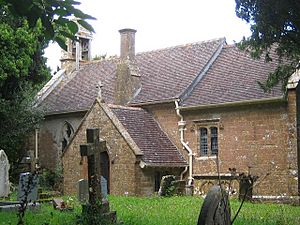Church of St Andrew, Thorne Coffin facts for kids
Quick facts for kids Church of St Andrew |
|
|---|---|
 |
|
| Location | Thorne Coffin, Somerset, England |
| Built | 14th century |
|
Listed Building – Grade II*
|
|
| Official name: Church of St Andrew | |
| Designated | 19 April 1961 |
| Reference no. | 1263070 |
| Lua error in Module:Location_map at line 420: attempt to index field 'wikibase' (a nil value). | |
The Church of St Andrew is a very old church located in Thorne Coffin, a small village in Somerset, England. It was built a long, long time ago in the 14th century. This means it's over 600 years old! Because it's so old and important, it's protected as a Grade II* listed building. This special status helps make sure the church is kept safe and looked after for many more years.
Contents
History of the Church
How Old Is It?
The Church of St Andrew was first built in the 1300s. Imagine all the history it has seen! Over the centuries, it has been cared for and updated. A big restoration, which means fixing it up, happened in 1891. This helped keep the old building strong and beautiful.
Special Parts Added Later
One interesting part of the church, the north porch, was added in 1613. This porch is like a small entrance room before you go into the main church. The church is part of a group of churches called the Five Crosses benefice. This group includes churches in nearby villages like Tintinhull and Chilthorne Domer. They all work together within the Diocese of Bath and Wells, which is a larger church area.
What the Church Looks Like
Outside the Church
The Church of St Andrew is made of stone and has a roof covered with tiles. On top of the roof, there's a small tower called a bellcote, which holds the church bell. The church has a main hall, called the nave, and a special area at the front, called the chancel. There are also small porches on both the north and south sides, which are like little entryways.
Inside the Church
When you go inside, you'll see many old things. Most of the items inside, like the font (a basin used for baptisms), are from the 1700s. However, there's one piece that's even older: the pulpit. This is a raised platform where the priest gives sermons. The pulpit is shaped like an octagon and dates all the way back to 1624!
The Churchyard
Around the church, there's a churchyard. It's surrounded by a tall wall, about 3 metres (9.8 ft) high. In the churchyard, you can find several old Yew trees. These trees are known for living a very long time, just like the church itself!

